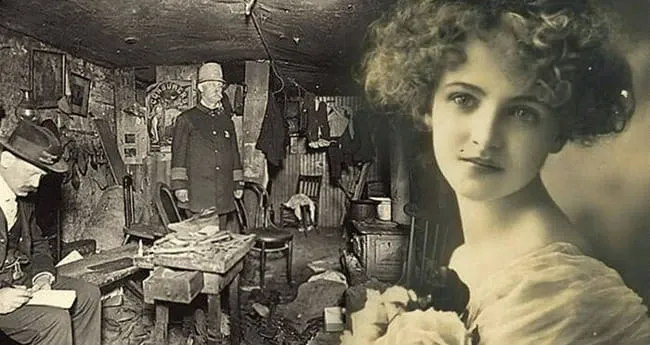The Creepy Story of Blanche Monnier
The Creepy Story of Blanche Monnier
Blanche Monnier (Poitiers, March 1, 1849 – Blois, October 13, 1913) was a woman who was held captive in her home for 25 years, known as the Séquestrée de Poitiers.
Blanche grew up as a modest and shy child.
Her relationships with her parents did not develop well, especially with her mother: the domineering woman completely controlled her daughter’s life, while her father was constantly busy and did not consider it necessary to participate in the upbringing of the heiress.
As she grew older, Blanche began to lead a more social life: she attended receptions, the most luxurious dinners, and was a welcome guest at every event.
By the way, according to contemporary witnesses, she was incredibly beautiful and intelligent: the noblest suitors sought Blanche’s favor, but she was in no hurry to make a choice, preferring to wait for true love.
In 1876, the girl’s expectations were fulfilled: during one of the receptions, Blanche met a respected lawyer who was almost twice her age and immediately fell in love.
The man reciprocated her feelings, and a whirlwind romance began between the lovers, which was supposed to end in marriage.
The Beginning of Captivity
Blanche’s mother, Louise Monnier, accused her daughter of choosing a simple lawyer, who not only did not belong to an aristocratic family but also lacked sufficient wealth and was much older than the girl, despite having the opportunity to marry the richest and noblest suitors in the city.
However, Blanche was not afraid of the prospect of arguing with her mother: she decided not to give up and continued her relationship with her lover, meeting him secretly in different parts of the city and planning to escape one day, leaving her parents’ house. This went on for a while, but in March 1876, Blanche suddenly disappeared.
Everyone was shocked by the sudden disappearance of the famous socialite, but Madame Monnier reassured neighbors and friends that Blanche had had an accident that caused her death.
This version satisfied everyone except the girl’s beloved, who did not give up searching for her and made many efforts to discover at least something about her whereabouts—but unfortunately, his efforts were unsuccessful.
In reality, Blanche was alive—the girl had been imprisoned by her mother, who locked her in a tiny dark room in the attic of their villa in the center of Poitiers, and gave her an ultimatum: to break off her relationship with the lawyer or face confinement.
Louise Monnier had an accomplice: her son Marcel, Blanche’s older brother. The young man knew perfectly well that his mother was holding his sister captive, but had no intention of saving her—in fact, he played the role of a grieving relative and convinced everyone that Blanche was dead.
It is unclear what motivated Marcel to support his mother; perhaps the young man suffered from mental illness and was under the influence of a domineering parent, and therefore did not understand what was really happening in their house.
The Anonymous Letter
On May 23, 1901, the Attorney General received an anonymous letter stating the following:
**”Mr. Attorney General, I have the duty to inform you of an exceptionally serious event. I speak of a spinster who is locked in Madame Monnier’s house, starving, and has been living in a filthy bed for twenty-five years—in a word, in her own filth.”**
The Rescue
The next day, police arrived and found Blanche in a state of starvation and extreme filth, weighing less than 30 kilograms, in the apartment at 21 rue de la Visitation (now rue Arthur Ranc). Blanche’s condition was described as follows after nearly a quarter of a century locked in the same room:
“We immediately ordered the window of the building to be opened. This was done with great difficulty, as a large amount of dust fell from the old dark curtains. To open the shutters, they had to be removed from the right-hand hinges. As soon as light entered the room, we noticed, lying on a bed behind, a head and body covered by a repulsively dirty blanket—a woman identified as Mademoiselle Blanche Monnier. The unfortunate woman was completely naked on a rotten straw mattress. All around her, a kind of crust had formed, made of excrement, fragments of meat, vegetables, fish, and rotten bread. We also saw oyster shells and insects running on Mademoiselle Monnier’s bed. The air was so unbreathable, the stench from the room so strong, that it was impossible to continue our investigation.”
The Sentence
On November 20, 1901, the Court of Appeal of Poitiers sentenced Marcel, the brother, to 15 months in prison.
The mother, after being arrested, was released due to heart problems, and she died two weeks later, on June 8, 1901.
Blanche arrived at the Hôtel-Dieu in Paris on June 1, 1901, and died twelve years later at the age of 64 in the psychiatric hospital in Blois: the mental disorders resulting from her inhumane imprisonment were extremely severe; even during her stay in the asylum, she never regained her mental faculties.
In 1941, during the Vichy France period, the “Law on the Omission of Assistance to Persons in Distress” was enacted, inspired by the case of Blanche Monnier.
Unfortunately, Blanche Monnier was never able to return to normal life: the psyche of the prisoner was paralyzed, and she suffered from anorexia nervosa, exhibitionism, and other behavioral disorders. The woman spent the rest of her life within the walls of a psychiatric hospital in the French town of Blois. She died in 1913 without regaining her sanity.
This monstrous story left a deep mark not only on the hearts of the locals who knew Blanche Monnier, but it also resonated in the works of some famous authors, including André Gide, who in 1930 presented to the public his work La Séquestrée de Poitiers, dedicated to the tragic fate of a woman.

Subscribe to our YouTube channel






